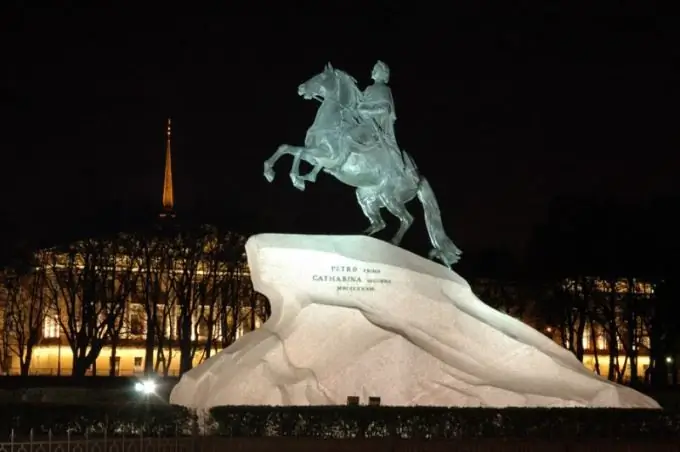- Author Antonio Harrison [email protected].
- Public 2023-12-16 07:44.
- Last modified 2025-01-22 21:44.
The Bronze Horseman is the most famous monument to Peter the Great in Russia, erected on Senate Square in St. Petersburg. It received its name, and with it wide popularity, after the publication of Pushkin's poem "The Bronze Horseman", although in fact it was cast from bronze.

The birth of an idea
The monument to Peter I was opened on August 7, 1782, its author is a sculptor from France Etienne-Maurice Falconet. It was created on the initiative of Catherine II. By order of the empress, the Russian envoy in Paris, Prince Golitsyn, turned for advice to Diderot and Voltaire, who recommended Falcone to him. The French sculptor at that time was already 50 years old, he served in a porcelain factory, but always dreamed of creating a work of monumental art. When an offer came from Russia, the master, without hesitation, signed a contract.
In October 1566, Falcone, along with his 17-year-old student Marie-Anne Collot, arrived in St. Petersburg. He soon began work on a life-size plaster model of the monument. It lasted for 12 years and was completed by 1778. Marie-Anne Collot sculpted Peter's head. The face of the king expresses will and courage, it is illuminated with deep thought. For this work, Collot was accepted as a member of the Russian Academy of Arts. Catherine II granted her a life pension of 10,000 livres. The snake under the horse's leg was made by the Russian sculptor Fyodor Gordeev.
The base of the monument was a rock, which was given the shape of a rearing wave. According to the sculptor's plan, it was supposed to serve as a reminder that it was Peter I who managed to turn Russia into a sea power. A granite block of a suitable size was found 12 versts from St. Petersburg. According to legend, lightning once hit it, after which a crack appeared in the rock. The rock was popularly called the Thunder Stone. Its weight was about 1600 tons. The thunder stone was delivered to the capital by barge within 9 months. During the transportation process, the stone was shaped into a wave. On September 26, 1770, the pedestal for the future statue was erected on Senate Square.
How the bronze rider turned to copper
For a long time they could not find a craftsman who would undertake the casting of a bronze statue. Foreigners were asking too high a price, and the Russians were intimidated by its supposed size. Finally, the cannon master Emelyan Khailov got down to business. Together with Falcone, they selected the optimal alloy composition and made samples. For 3 years, while the preparatory work lasted, the sculptor perfectly mastered the technique of bronze casting.
Casting of the monument began in 1774. However, it was not done with one filling. The pipe burst, through which the red-hot bronze entered the mold. The upper part of the sculpture was hopelessly damaged. It took another 3 years to prepare for the refill. Fortunately, this time, the idea was a success.
However, such a long work on the statue greatly spoiled Falcone's relationship with Catherine II. As a result, the sculptor left Russia without waiting for the installation of his creation. No more sculptures were created by him. Alexander Sergeevich Pushkin called the bronze statue "The Bronze Horseman" in his poem. The name became so popular that it almost became the official one.






